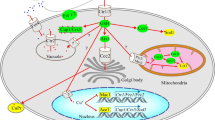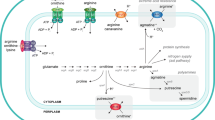Abstract
In Saccharomyces cerevisiae, adaptation to hypoxia/anaerobiosis requires the transcriptional induction or derepression of multiple genes organized in regulons controlled by specific transcriptional regulators. Ixr1p is a transcriptional regulatory factor that causes aerobic repression of several hypoxic genes (COX5B, TIR1, and HEM13) and also the activation of HEM13 during hypoxic growth. Analysis of the transcriptome of the wild-type strain BY4741 and its isogenic derivative Δixr1, grown in aerobic and hypoxic conditions, reveals differential regulation of genes related not only to the hypoxic and oxidative stress responses but also to the re-adaptation of catabolic and anabolic fluxes in response to oxygen limitation. The function of Ixr1p in the transcriptional regulation of genes from the sulfate assimilation pathway and other pathways producing α-keto acids is of biotechnological importance for industries based on yeast-derived fermentation products.



Similar content being viewed by others
References
Abramova NE, Cohen BD, Sertil O, Kapoor R, Davies KJ, Lowry CV (2001a) Regulatory mechanisms controlling expression of the DAN/TIR mannoprotein genes during anaerobic remodeling of the cell wall in Saccharomyces cerevisiae. Genetics 157:1169–1177
Abramova NE, Sertil O, Mehta S, Lowry CV (2001b) Reciprocal regulation of anaerobic and aerobic cell wall mannoprotein gene expression in Saccharomyces cerevisiae. J Bacteriol 183:2881–2887
Alberola TM, García-Martínez J, Antúnez O, Viladevall L, Barceló A, Ariño J, Pérez-Ortín JE (2004) A new set of DNA macrochips for the yeast Saccharomyces cerevisiae: features and uses. Int Microbiol 7:199–206
Becerra M, Lombardía-Ferreira LJ, Hauser NC, Hoheisel JD, Tizon B, Cerdán ME (2002) The yeast transcriptome in aerobic and hypoxic conditions: effects of hap1, rox1, rox3 and srb10 deletions. Mol Microbiol 43:545–555, Erratum in: Mol Microbiol 45:265
Bourdineaud JP, De Sampaio G, Lauquin GJ (2000) A Rox1-independent hypoxic pathway in yeast. Antagonistic action of the repressor Ord1 and activator Yap1 for hypoxic expression of the SRP1/TIR1 gene. Mol Microbiol 38:879–890
Brown SJ, Kellett PJ, Lippard SJ (1993) Ixr1, a yeast protein that binds to platinated DNA and confers sensitivity to cisplatin. Science 261:603–605
Castro-Prego R, Lamas-Maceiras M, Soengas P, Fernández-Leiro R, Carneiro I, Becerra M, González-Siso MI, Cerdán ME (2010a) Ixr1p regulates oxygen-dependent HEM13 transcription. FEMS Yeast Res 10:309–321
Castro-Prego M, Lamas-Maceiras M, Soengas P, Carneiro I, González Siso MI, Cerdán ME (2010b) Regulatory factors controlling transcription of Saccharomyces cerevisiae IXR1 (ORD1) by oxygen levels. A model of transcriptional adaptation from aerobiosis to hypoxia implicating ROX1 and IXR1 cross-regulation. Biochem J 425:235–243
Collinson EJ, Wheeler GL, Garrido EO, Avery AM, Avery SV, Grant CM (2002) The yeast glutaredoxins are active as glutathione peroxidases. J Biol Chem 277:16712–16717
Colón M, Hernández F, López K, Quezada H, González J, López G, Aranda C, González A (2011) Saccharomyces cerevisiae Bat1 and Bat2 aminotransferases have functionally diverged from the ancestral-like Kluyveromyces lactis orthologous enzyme. PLoS One 6:e16099
Chomczynski P, Sacchi N (1987) Single-step method of RNA isolation by acid guanidinium thiocyanate–phenol–chloroform extraction. Anal Biochem 162:156–159
David PS, Poyton RO (2005) Effects of a transition from normoxia to anoxia on yeast cytochrome c oxidase and the mitochondrial respiratory chain: implications for hypoxic gene induction. Biochim Biophys Acta 1709:169–180
Deckert J, Khalaf RA, Hwang SM, Zitomer RS (1999) Characterization of the DNA binding and bending HMG domain of the yeast hypoxic repressor Rox1. Nucleic Acids Res 27:3518–3526
Deckert J, Rodríguez Torres AM, Simon JT, Zitomer RS (1995) Mutational analysis of Rox1, a DNA-bending repressor of hypoxic genes in Saccharomyces cerevisiae. Mol Cell Biol 15:6109–6117
Dirmeier R, O’Brien KM, Engle M, Dodd A, Spears E, Poyton RO (2002) Exposure of yeast cells to anoxia induces transient oxidative stress. Implications for the induction of hypoxic genes. J Biol Chem 277:34773–34784
Hamada K, Fukuchi S, Arisawa M, Baba M, Kitada K (1998) Screening for glycosylphosphatidylinositol (GPI)-dependent cell wall proteins in Saccharomyces cerevisiae. Mol Gen Genet 258:53–59
Hansen J, Muldbjerg M, Chérest H, Surdin-Kerjan Y (1997) Siroheme biosynthesis in Saccharomyces cerevisiae requires the products of both the MET1 and MET8 genes. FEBS Lett 401:20–24
Hauser NC, Vingron M, Scheideler M, Krems B, Hellmuth K, Entian KD, Hoheisel JD (1998) Transcriptional profiling on all open reading frames of Saccharomyces cerevisiae. Yeast 14:1209–1221
Kastaniotis AJ, Zitomer RS (2000) Rox1 mediated repression. Oxygen dependent repression in yeast. Adv Exp Med Biol 475:185–195
Klinkenberg LG, Mennella TA, Luetkenhaus K, Zitomer RS (2005) Combinatorial repression of the hypoxic genes of Saccharomyces cerevisiae by DNA binding proteins Rox1 and Mot3. Eukaryot Cell 4:649–660
Kwast KE, Burke PV, Staahl BT, Poyton RO (1999) Oxygen sensing in yeast: evidence for the involvement of the respiratory chain in regulating the transcription of a subset of hypoxic genes. Proc Natl Acad Sci USA 96:5446–5451
Kwast KE, Lai LC, Menda N, James DT, Aref S, Burke PV (2002) Genomic analyses of anaerobically induced genes in Saccharomyces cerevisiae: functional roles of Rox1 and other factors in mediating the anoxic response. J Bacteriol 184:250–265
Labbe-Bois R, Labbe P (1990) Tetrapyrrole and heme biosynthesis in the yeast Saccharomyces cerevisiae. In: Dailey HA (ed) Biosynthesis of heme and chlorophylls. McGraw-Hill, New York, pp 235–285
Lambert JR, Bilanchone VW, Cumsky MG (1994) The ORD1 gene encodes a transcription factor involved in oxygen regulation and is identical to IXR1, a gene that confers cisplatin sensitivity to Saccharomyces cerevisiae. Proc Nat Acad Sci USA 91:7345–7349
Luikenhuis S, Perrone G, Dawes IW, Grant CM (1998) The yeast Saccharomyces cerevisiae contains two glutaredoxin genes that are required for protection against reactive oxygen species. Mol Biol Cell 9:1081–1091
McA’Nulty MM, Whitehead JP, Lippard SJ (1996) Binding of Ixr1, a yeast HMG-domain protein, to cisplatin–DNA adducts in vitro and in vivo. Biochemistry 35:6089–6099
Regnacq M, Alimardani P, El Moudni B, Berges T (2001) Sut1p interaction with Cyc8p (Ssn6p) relieves hypoxic genes from Cyc8p-Tup1p repression in Saccharomyces cerevisiae. Mol Microbiol 40:1085–1096
Robinson MD, Grigull J, Mohammad N, Hughes TR (2002) FunSpec: a web-based cluster interpreter for yeast. BMC Bioinforma 3:e35
Smits GJ, Kapteyn JC, van Den EH, Klis FM (1999) Cell wall dynamics in yeast. Curr Opin Microbiol 2:348–352
Tsaponina O, Barsoum E, Astrom SU, Chabes A (2011) Ixr1 is required for the expression of the ribonucleotide reductase Rnr1 and maintenance of dNTP pools. PLoS Genet 7:e1002061
Ter Linde JJ, Steensma HY (2002) A microarray-assisted screen for potential Hap1 and Rox1 target genes in Saccharomyces cerevisiae. Yeast 19:825–840
Thomas D, Barbey R, Surdin-Kerjan Y (1990) Gene-enzyme relationship in the sulphate assimilation pathway of Saccharomyces cerevisiae. Study of the 3′-phosphoadenylylsulphate reductase structural gene. J Biol Chem 265:15518–15524
Thomas D, Barbey R, Henry D, Surdin-Kerjan Y (1992) Physiological analysis of mutants of Saccharomyces cerevisiae impaired in sulphate assimilation. J Gen Microbiol 138:2021–2028
Thomas D, Surdin-Kerjan Y (1997) Metabolism of sulfur amino acids in Saccharomyces cerevisiae. Microbiol Mol Biol R 61:503–532
Vik A, Rine J (2001) Upc2p and Ecm22p, dual regulators of sterol biosynthesis in Saccharomyces cerevisiae. Mol Cell Biol 21:6395–6405
Zitomer RS, Lowry CV (1992) Regulation of gene expression by oxygen in Saccharomyces cerevisiae. Microbiol Rev 56:1–11
Zitomer RS, Carrico P, Deckert J (1997) Regulation of hypoxic gene expression in yeast. Kidney Int 51:507–513
Acknowledgments
This research was supported by grants BFU2006-03961 and BFU2009-08854 from MICINN (Spain), co-financed by FEDER (CEE). General support to the laboratory during 2008-11 was funded by Xunta de Galicia (Consolidación C.E.O.U.2008/008), co-financed by FEDER. A.V’s salary was funded by the “Lucas-Labrada program-2008” from Xunta de Galicia.
Author information
Authors and Affiliations
Corresponding author
Electronic supplementary materials
Below is the link to the electronic supplementary material.
ESM 1
(DOC 2821 kb)
Fig. S1
Cluster analysis of DEGs included in ESM Table S1 (a), ESM Table S2 (b), and ESM Table S3 (c) with Genespring. The values analyzed are the means of significant changes in expression obtained from independent cultures as described in the experimental design in “Materials and methods.” The genes that are above the median of the normalized values between the different samples are shown in red and those below shown in blue. The color intensity is proportional to the normalized values, as shown on the scale at the bottom of the figure. Cells were grown under normoxia (a), hypoxia (b), or after a hypoxic sift (c) (PPT 235 kb)
Rights and permissions
About this article
Cite this article
Vizoso-Vázquez, Á., Lamas-Maceiras, M., Becerra, M. et al. Ixr1p and the control of the Saccharomyces cerevisiae hypoxic response. Appl Microbiol Biotechnol 94, 173–184 (2012). https://doi.org/10.1007/s00253-011-3785-2
Received:
Revised:
Accepted:
Published:
Issue Date:
DOI: https://doi.org/10.1007/s00253-011-3785-2




